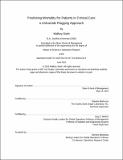Predicting mortality for patients in critical care : a univariate flagging approach
Author(s)
Sheth, Mallory
DownloadFull printable version (2.651Mb)
Other Contributors
Massachusetts Institute of Technology. Operations Research Center.
Advisor
Natasha Markuzon and Roy E. Welsch.
Terms of use
Metadata
Show full item recordAbstract
Predicting outcomes for critically ill patients is a topic of considerable interest. The most widely used models utilize data from early in a patient's stay to predict risk of death. While research has shown that use of daily information, including trends in key variables, can improve predictions of patient prognosis, this problem is challenging as the number of variables that must be considered is large and increasingly complex modeling techniques are required. The objective of this thesis is to build a mortality prediction system that improves upon current approaches. We aim to do this in two ways: 1. By incorporating a wider range of variables, including time-dependent features 2. By exploring different predictive modeling techniques beyond standard regression We identify three promising approaches: a random forest model, a best subset regression containing just five variables, and a novel approach called the Univariate Flagging Algorithm (UFA). In this thesis, we show that all three methods significantly outperform a widely-used mortality prediction approach, the Sequential Organ Failure Assessment (SOFA) score. However, we assert that UFA in particular is well-suited for predicting mortality in critical care. It can detect optimal cut-points in data, easily scales to a large number of variables, is easy to interpret, is capable of predicting rare events, and is robust to noise and missing data. As such, we believe it is a valuable step toward individual patient survival estimates.
Description
Thesis: S.M., Massachusetts Institute of Technology, Sloan School of Management, Operations Research Center, 2015. This electronic version was submitted by the student author. The certified thesis is available in the Institute Archives and Special Collections. Cataloged from student-submitted PDF version of thesis. Includes bibliographical references (pages 87-89).
Date issued
2015Department
Massachusetts Institute of Technology. Operations Research Center; Sloan School of ManagementPublisher
Massachusetts Institute of Technology
Keywords
Operations Research Center.